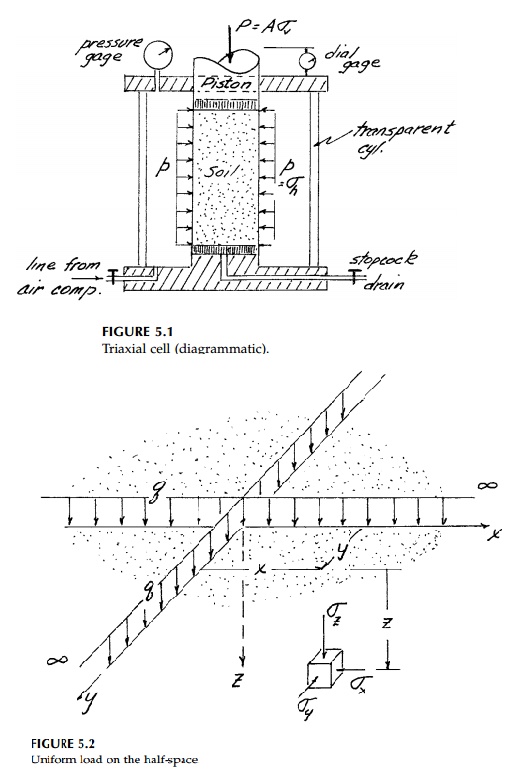Chapter: Civil : Principles of Solid Mechanics : Linear Free Fields
Uniform Stress
Uniform Stress
If, in some orientation (x,y,z),
shear stresses vanish throughout the body and the normal stresses are constant
everywhere,

and all the field equations are satisfied. Strains are also constant giving the displacements by finite linear transformation as discussed in Chapter 1. If one stress is zero, the general case reduces to plane stress or, if say σy =v(σx + σz), there is uniform plane strain (Ey = 0).
Another common situation is the triaxial state where
two of the stresses are equal, say:

Unlike plane stress or
plane strain, the triaxial field really is two-dimensional, in that, because
the stresses are isotropic in the x-y plane, there is only one
Mohr’s Circle throughout the body.
We create this situation in the laboratory in a
triaxial cell by first pressurizing the sample in a chamber to some confining
pressure, �'p, and then increasing or decreasing the vertical stress with
weights or with a hydraulic piston (Figure 5.1). This device is particularly
useful for testing granular materials, which have little or no tensile
strength. Both invariants can be controlled independently. A pure deviatoric
test can be devised to determine the shear modulus, G, and

yield point. For
example, the confining pressure can be decreased while the vertical stress is
increased such that the radius of Mohr’s Circle grows while the mean stress
remains constant. Conversely, we can determine the bulk modulus, K, by
keeping σz =-
p throughout
the test. A uniaxial state of uniform stress is achieved corresponding
to an unconfined compression test if p = 0.
Depending on the boundary conditions and material
properties, all of these uniform stress fields can occur in the half-space
loaded by a constant surface load, q (Figure 5.2). Because of the
semi-infinite geometric condition, there can be no shear strains and Ex
=
Ey
=
0. Therefore

If v = 0, then the solution
reduces to a simple uniaxial field of unconfined compression or if v=0.5 .5 (incompressible), it becomes the isotropic field of hydrostatic compression
(σx
= σy
= σz
=-
q).
Related Topics